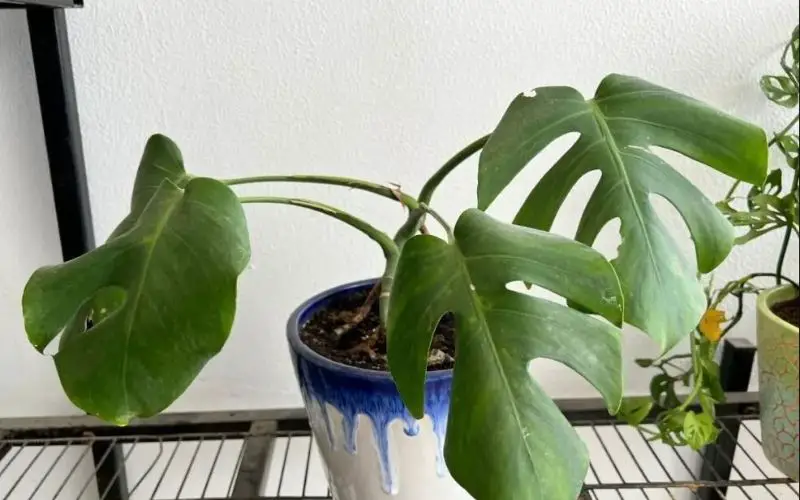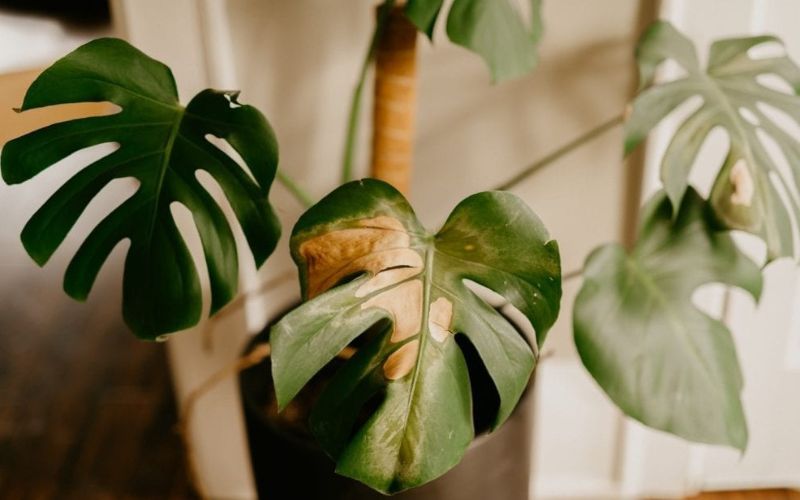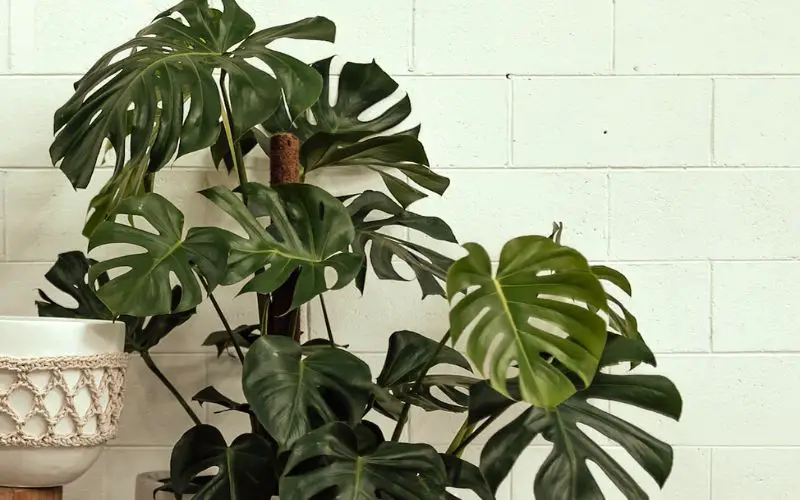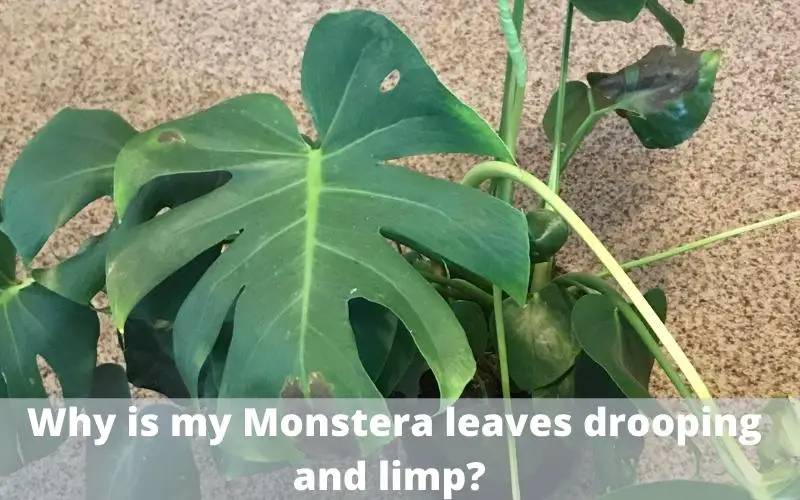The most common issue asked by Monstera gardeners is: why is my Monstera leaves drooping, although the main culprit is a lack of water? They prefer their soil to be somewhat wet at all times. Overwatering, inadequate light, fertilizer issues, pests, and transplant stress are all possible causes. The most critical step in nursing your plant back to health is identifying the problem.
Why is my Monstera leaves drooping and limp?
If the leaves on your Monstera are withering or the whole plant is drooping, take a good look at it and reread the care instructions to figure out what’s wrong. The good thing for Monstera is the fact that it is robust, and if you take care of it and properly, it will soon get back to its strength. Let’s take a look at each reason for drooping Monstera leaves one by one.
Incredibly dry soil
Your Monstera loves continually wet soil. Check to see if you’re excessively watering or overwatering your plants. Follow a regular watering schedule, and water after your top 2″-3″ of the soil has dried.
If you let the soil on your Monstera dry up entirely, the leaves will become limp, droop, and potentially brown. A thorough soak is required if the soil is excessively dry throughout the container.

To soak water your Monstera, follow these steps:
- Remove the saucer from your plant and place it in your sink or tub. Fill your basin with 3 to 4 inches of water. Make certain the water is not too hot!
- Allow at least 45 minutes for your plant to absorb water via the drainage hole on the bottom of the pot.
- After your plant has been soaking, check to see if the water has reached the top 2-3″ of soil.
- If the soil does not feel completely soaked, water your Monstera from the top to assist speed up the process.
- Drain the sink/tub when your plant’s soil is uniformly moist and allow the plant to rest while it drains completely. Replace the plant on its saucer and in its rightful location.
Overwatering Problem
Overwatering, like a lack of water, causes the Monstera plant’s lush foliage to droop. Overwatering causes the Swiss Cheese plant’s leaves to grow thin and yellow.
The faint steam and leaves will begin to droop after a few days. Overwatering is also characterized by brown stains on the leaf tips and foul pot soil.
The stench suggests rot root, which might lead to your houseplant’s death. Find a container that has drainage holes as well as a fresh soil mix to avoid repeat mistakes.
These holes allow excess rainwater from the soil to drain. Remember to water the Monstera plant according to the directions to avoid overwatering.

Solutions:
We’ve discovered that the most efficient method to water the Monstera is to set your Monstera in the bathroom sink or utilize a watering bottle to add water slowly until it begins to flow through the drain holes.
Empty the drainage tray right away. Don’t overwater the soil, and maintain draining the drainage tray as needed.
Avoid getting the leaves wet as well. Instead of watering the plant directly, pour it into the soil.
It is recommended to repot to make your Monstera one size bigger (for instance, changing from 6” to up to eight inches’ pot).
Indoor Monsteras can be grown in ceramic containers (with drain holes). There are numerous styles available, albeit larger ones may be more expensive.
Indicate drainage issues
Drainage concerns in your pot might potentially cause drooping leaves on your Monstera. Even though you’re watering in the right amount, however, if your container isn’t draining properly this could result in the soil becoming wet. By adding just a small amount of perlite, you’ll just increase the amount of drainage your soil has which makes it much easier than water flows through the drainage holes of your pots. (You must ensure that your pots are equipped with drain holes.)

Solution:
Another simple step is to place a few tiny stones or pebbles in the bottom of your pots to ensure that the drainage holes are never clogged by soil or other debris.
Read More: Why is Monstera leaves turning brown & How to Fix Them
Temperature Stress
Monstera plants are less resistant to extreme temperature swings. If the houseplant is kept in a hot atmosphere, the leaves will droop and the stem will become limp.
Room temperatures of 60-80 degrees Fahrenheit are ideal for Your Monstera. Cold conditions also affect these Swiss Cheese plants.
Cold weather also weakens the Swiss Cheese plant. This might be another reason for Monstera leaves limping and drooping.
It is not resistant to temperatures below 55 degrees Fahrenheit or sudden temperature drops. Avoid frigid gusts and direct airflow from heaters in the winter.
If you suspect you have a temperature issue, you can utilize a digital thermometer to take note of the highest and lowest temperatures over a couple of days. Then, transfer your plant when needed

Solution:
If you live in a dry region, spraying your Monstera deliciosa once a week may assist to increase the humidity around it.
Similar to the winter months you can fill the cups with tap water and set them on the window’s ledge. The water will evaporate during the day, causing an increase in the humidity of the room, making Your Monstera Deliciosa happy.
Use a humidifier to quickly increase and maintain appropriate humidity levels. There are several sorts of humidifiers on the market, each serving a different function.
Too much light
Excessive sunshine promotes higher water loss through transpiration as the plant attempts to cool itself. We hope you are aware that plants use extra light to generate heat. In addition, the earth will dry faster. If the loss exceeds the rate of absorption, your plant will wilt.
The leaves will have a burned appearance, with crispy brown edges or tips and dry, discolored spots. They also look bleached or washed (paler or yellowish, with the exception of veins). More indicators include curled leaves or their edges twisting up. Furthermore, if this continues for an extended period of time, leaves will begin to fall off prematurely.

Solution:
Move the plant to a shade if the following indicators appear on leaves that are closer to the source of light or receive direct sunshine. If you’re using a grow light, you may also use shade cloth and keep your plants at a safe distance.
If they’re near a south-facing window, transfer them to a location where direct sunlight won’t reach them. Increase humidity and watering frequency to assist deal with too much light. However, excessive irrigation might lead to additional problems.
Infestation of Insects and Pests
The same sap-sucking suspects that assault most indoor foliage plants, particularly mealy bugs and red spider mites, attack these plants. The primary and most crucial line of defense is constant observation.
A major insect infestation can cause the plant to lose a lot of water and nutrients due to the damage to its leaves, causing your Monstera leaves to droop and the entire plant to die.
Solution:
Spraying the plant leaves with a reliable houseplant pesticide. All insects will be exterminated, and the pesticide will prevent your plant from drooping leaves.
| Types of Pests in Monstera | Symptoms | Treatment |
| Scale Insects | Scale creates white or yellow spots on leaves that eventually become yellow and fall off. | Apply to rub alcohol on the scale using a cotton swab. |
| Spider Mites | The leaves may feel sticky or gritty, particularly at the bottom of the leaf, where they like to congregate. | Spider mites can be immediately reduced by showering the plant or hosing it down outside. |
| Thrips | They have the appearance of little white footballs and reside on the undersides of leaves, producing holes. | Thrips can also be knocked off the plant by a strong stream of water, such as from a garden hose. |
| Fungus Gnats | When you water your plants, you’ll undoubtedly notice fungus gnats crawling on the top of the soil or flying out from the pot, creating a white or black powdery residue. | It’s also a good idea to water from the bottom rather than the top. Fungus gnat larvae live in the soil’s top layer. |
Read More: How to detect bugs on Monstera? The most common insects
Lack of Proper Lighting
Monsteras extend out towards their light source as they grow and generate new leaves. If your Monstera isn’t getting enough natural light, it will grow longer and longer stems in an attempt to acquire more.
As you may expect, this results in longer, thinner, more top-heavy stems that are more prone to drooping.

Solution:
If the final few new leaves on your Monstera appear to be lanky and lengthy, consider relocating it to a location where it will receive more natural light throughout the day.
If additional natural light isn’t an option for now, consider artificial choices like LED grow lights, which are ideal for those of us who don’t have many large windows or who live in areas with very long dark winters.
Over-Fertilization
Monstera plants may grow to be fairly tall in their native environment. Swiss cheese, on the other hand, is often cultivated in pots, which limits its height.
You must offer adequate nutrients to guarantee that the plant grows to its greatest potential. However, too much fertilizer applied too frequently can generate a build-up in the soil, which can cause root toxicity.
If the roots stop working and the plant can’t get the water and nutrients it needs, the Monstera plant will droop.
Aside from that, using too much fertilizer increases soil toxicity. The root tips are unable to function properly, leading the Monstera plant to droop.

Solution:
Monstera, like other foliage plants, requires a 3-1-2 N-P-K ratio, which is three parts nitrogen to one part phosphorus to two parts potassium. These three macronutrients support the health of your plant’s leaves, stems, and roots, as well as blooming and leaf splitting.
Fertilizers, both liquid and solid, may have fantastic results. However, fertilizer spikes should not be used since they may cause overfertilization problems.
Whatever sort of fertilizer you use, make sure to dilute it. It’s better to under-fertilize than to over-fertilize your plants.
Use a general-purpose fertilizer throughout the summer and spring. During the slower-growing winter season, you can reduce this to one feed every month.
Lack of care
You’ll understand why Monsteras in pots fall over if you’ve ever seen one in the wild.
Their normal growth strategy is to link to trees and rise, relying on their anchor roots for support along the way.
When a Monstera is young, it is light enough to stand on its own. When it gets large enough, however, it has nothing to cling to, and the weight of the leaves and stalks falls to the ground in search of support.
It may become unstable enough to overturn the entire pot, depending on the type of pot.
Solution:
Use non-degradable cedar poles or a sturdy moss pole to stake the Monstera. Plant ties can be used to bind the Monstera to the stake after it is in situ.
Similarly, you may teach your Monstera to grow upright by using a trellis constructed of wood or metal. A triangular or rectangular trellis can support more and heavier leaves than a single rod since it has several support points.
Bamboo, wood, and metal are common materials for garden stakes. They all work well but choose one that is powerful enough to keep your plant alive.
Tip to care Monstera drooping after repotting
After potting, water the pot well. After a week or two, resume a monthly liquid fertilizer feeding during watering. The Swiss cheese plant may just outgrow its surroundings. The plant may grow up to 10 feet (3 meters) tall in its natural environment.
In the home, it is typically overly tall, but the plant will respond well to pruning. Additionally, any cuttings can be kept and put to use in the creation of the next plant.
Clean the leaves and be on the lookout for signs of spider mites. If you take care of it this glossy plant will last for years and will reward you with gorgeous delicate leaves.


